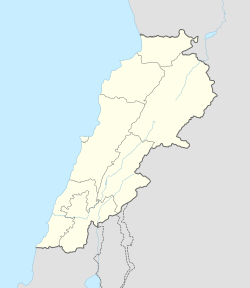Top Qs
Timeline
Chat
Perspective
Burj Rahal
Municipality in South Governorate, Lebanon From Wikipedia, the free encyclopedia
Remove ads
Burj Rahal (Arabic: برج رحال) is a municipality in the Tyre District in South Lebanon.
Etymology

According to E. H. Palmer in 1881, the name Burj Rahhal means "the traveller’s tower".[2]
History
Summarize
Perspective
In the 1860s, Ernest Renan found here seven singular constructions in a row, three being open, the rest closed. He was also informed that to the north-east of these, there were seven more hidden under grounds. The locals call them the Tombs of the Tyrian Kings, Kubur el Moluk.[3]
In 1875, Victor Guérin found here a village with 400 Metawileh inhabitants.[4] "Here are seen good cut stones lying here and there, taken from an ancient fort."[5]
He further noted: "Ten minutes to the west of the village I observed three good subterranean magazines contiguous and parallel. Partly cut in the rock and partly constructed of cut stones, they measure ten metres in length by a breadth not greater than a metre and a half. They are covered within by a stony cement, in which are inserted fragments of pottery, and arc surmounted by great inclined slabs forming a triangular roof. These are covered over by a layer of earth, so as to form a platform. Several other similar caves are adjoining them, but they are at the present moment closed. Formerly they probably served as oil and wine- cellars, or stores for corn. The place is called Kh. Mahatma."[5]
In 1881, the PEF's Survey of Western Palestine (SWP) described it as: "A large village built of stone, containing 150 Metawileh, on a ridge, surrounded by figs, olives, and arable land. There is a good spring and well near."[6] They further noted: "A few more minutes to the west, Guérin found a ruin called Kh. Kerry el Meserta, where he observed the uprights of grooved oil-presses, broken sarcophagi, mill stones, numerous little cubes of mosaic scattered about, and a great cistern extending under a platform. At twenty minutes' march west-south-west of El Meserta, he observed a hillock with the remains of a ruined village called Kh. Halua. Not far from this place, to the east-north-east, he found a platform surrounded by a wall of large stones, having a great cistern hollowed in the middle. It is called Bir el Mellaha."[7]
Remove ads
Demographics
In 2014 Muslims made up 99.89% of registered voters in Burj Rahal. 99.40% of the voters were Shiite Muslims.[8]
References
Bibliography
External links
Wikiwand - on
Seamless Wikipedia browsing. On steroids.
Remove ads


